Nissan Juke Service and Repair Manual : Rear seat belt
Exploded View
2WD models
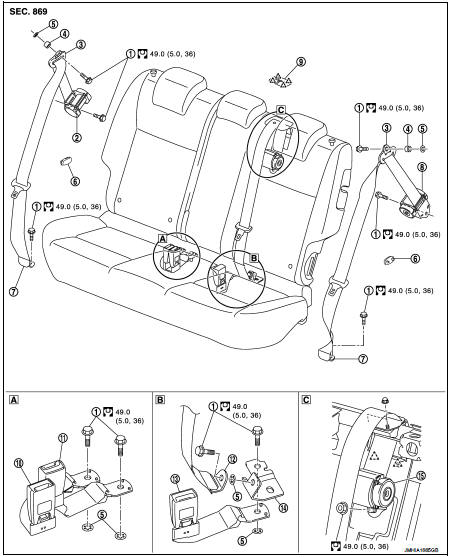
1. Anchor bolt
2. Outer seat belt retractor RH
3. Shoulder anchor
4. Space
5. Retaining washer
6. Seat belt hook
7. Outer anchor
8. Outer seat belt retractor LH
9. Center seat belt finisher
10. Center seat belt buckle
11. RH seat belt buckle
12. Center anchor
13. LH seat belt buckle
14. Seat belt joint bracket
15. Center seat belt retractor
 : Pawl
: Pawl
 : N·m (kg-m, ft-lb)
: N·m (kg-m, ft-lb)
4WD models
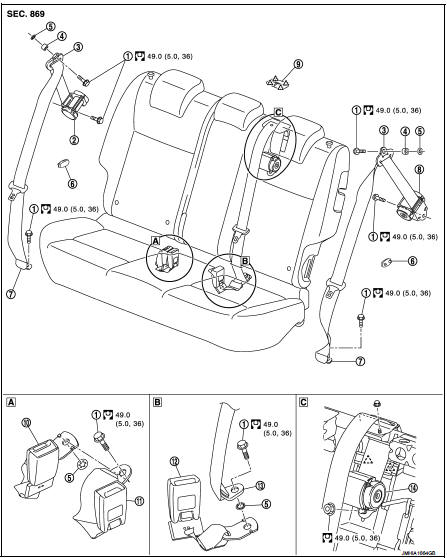
1. Anchor bolt
2. Outer seat belt retractor RH
3. Shoulder anchor
4. Space
5. Retaining washer
6. Seat belt hook
7. Outer anchor
8. Outer seat belt retractor LH
9. Center seat belt finisher
10. RH seat belt buckle
11. Center seat belt buckle
12. LH seat belt buckle
13. Center anchor
14. Center seat belt retractor
 : Pawl
: Pawl
 : N·m (kg-m, ft-lb)
: N·m (kg-m, ft-lb)
Seat belt retractor : Removal and Installation
REMOVAL
Outer seat belt retractor (2WD models) 1. Remove outer anchor.
1. Remove rear seat cushion from the vehicle. Refer to SE-33, "SEAT CUSHION : Removal and Installation".
2. Remove outer anchor mounting anchor bolt.
2. Remove shoulder anchor.
1. Remove rear seatback from the vehicle. Refer to SE-33, "SEATBACK : Removal and Installation".
2. Remove luggage side lower finisher. Refer to INT-31, "LUGGAGE SIDE LOWER FINISHER : Removal and Installation".
3. Remove luggage side upper finisher. Refer to INT-32, "LUGGAGE SIDE UPPER FINISHER : Removal and Installation".
4. Remove shoulder anchor mounting anchor bolt.
3. Remove outer seat belt retractor mounting anchor bolt, and then remove outer seat belt retractor.
Outer seat belt retractor (4WD models) 1. Remove outer anchor.
1. Remove rear seatback from the vehicle. Refer to SE-43, "SEATBACK : Removal and Installation".
2. Remove rear seat cushion from the vehicle. Refer to SE-42, "SEAT CUSHION : Removal and Installation".
3. Remove luggage side lower finisher. Refer to INT-31, "LUGGAGE SIDE LOWER FINISHER : Removal and Installation".
4. Remove outer anchor mounting anchor bolt.
2. Remove shoulder anchor.
1. Remove luggage side upper finisher. Refer to INT-32, "LUGGAGE SIDE UPPER FINISHER : Removal and Installation".
2. Remove shoulder anchor mounting anchor bolt.
3. Remove outer seat belt retractor mounting anchor bolt, and then remove outer seat belt retractor.
Center seat belt retractor 1. Remove center anchor.
1. Remove rear seat cushion from the vehicle. Refer to SE-33, "SEAT CUSHION : Removal and Installation".
2. Remove center anchor mounting anchor bolt.
2. Remove rear seatback LH from the vehicle. Refer to SE-33, "SEATBACK : Removal and Installation".
3. Remove center seat belt finisher from seatback.
Lift up front of center seat belt finisher. Disengage front pawls.
Pull center seat belt finisher toward seat front. Disengage rear pawls.
 : Pawl
: Pawl
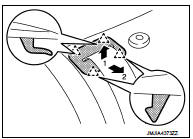
4. Remove seatback trim and seatback pad from seatback frame.
• 2WD models: Refer to SE-35, "SEATBACK : Disassembly and Assembly".
• 4WD models: Refer to SE-44, "SEATBACK : Disassembly and Assembly".
5. Remove seatback silencer from seatback frame.
6. Remove center seat belt retractor.
1. Remove mounting nuts (A) of upper webbing guide (1). Remove upper webbing guide (1) from seatback frame.
2. Disengage pawls of lower webbing guide (2). Remove lower webbing guide (2) in direction indicated by arrow as shown in the figure.
3. Remove mounting anchor nut (B) of center seat belt retractor (3) from seatback frame.
 : Pawl
: Pawl
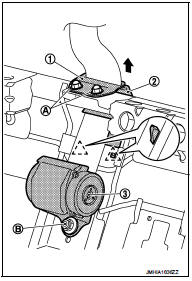
INATALLATION
Install in the reverse order of removal.
Seat belt retractor : Inspection
AFTER A COLLISION
WARNING:
Inspect all seat belt assemblies including retractors and attached hardware
after any collision.
NISSAN/INFINITI recommends that all seat belt assemblies in use during a collision be replaced unless the collision was minor and the belts show no damage and continue to operate properly. Failure to do so could result in serious personal injury in an accident. Seat belt assemblies not in use during a collision should also be replaced if either damage or improper operation was noted. Seat belt pre-tensioners should be replaced even if the seat belts were not in use during a frontal collision in which the air bags were deployed.
Replace any seat belt assembly (including anchor bolts) if: • The seat belt is in use at the time of a collision (except for minor collisions and the belts, retractors and buckles show no damage and continue to operate properly).
• The seat belt is damaged in an accident (i.e. torn webbing, bent retractor or guide, etc.).
• The seat belt attaching point is damaged in an accident. Inspect the seat belt attaching area for damage or distortion and repair if necessary before installing a new seat belt assembly.
• Anchor bolts are deformed or worn out.
• The seat belt pre-tensioners must be replaced even if the seat belts were not in use during the collision in which the air bags were deployed.
PRELIMINARY CHECKS
1. Check that the seat belt retractor, seat belt anchor and buckle bolts are tightened firmly.
2. Check retractor operation: a. Fully extend the seat belt webbing and check for twists, tears or other damage.
b. Allow the seat belt to retract. Check that webbing returns smoothly and completely into the retractor. If the seat belt does not return smoothly, wipe the inside of the loops with a clean paper cloth. Dirt build-up in the loops of that upper anchors can cause the seat belts to retract slowly.
c. Fasten the seat belt. Check that seat belt returns smoothly and completely to the retractor. If the webbing does not return smoothly, the cause may be an accumulation of dust or dirt. Use the “SEAT BELT TAPE
SET” and perform the following steps.
3. Repeat steps above if necessary to check the other seat belts.
SEAT BELT RETRACTOR ON-VEHICLE CHECK Emergency Locking Retractors (ELR) NOTE
:
All seat belt retractors are Emergency Locking Retractors (ELR) type. In an
emergency (sudden stop) the
retractor will lock and prevent the webbing from extending any further.
Check the seat belt retractors with the following test(s) to determine if a retractor assembly is operating normally.
ELR Function Stationary Check Grasp the shoulder webbing and pull forward quickly. The retractor should lock and prevent the belt from extending further.
ELR Function Moving Check
WARNING:
Perform the following test in a safe, open area clear of other vehicles and
obstructions (for example, a
large, empty parking lot). Road surface must be paved and dry. Never perform the
following test on
wet or gravel roads or on public streets and highways. This could result in an
accident and serious
personal injury. The driver and passenger must be prepared to brace themselves
in the event that the
retractor does not lock.
1. Fasten driver seat belt. Buckle a passenger into the seat for the belt that is to be tested.
2. Proceed to the designated safe area.
3. Drive the vehicle at approximately 16 km/h (10 MPH). Notify any passengers of a pending sudden stop and the driver and passenger must be prepared to brace themselves in the event that the retractor does not lock. Apply brakes firmly and make a very hard stop.
During stopping, seat belts should lock and not be extended. If the seat belt retractor assembly does not lock, perform the retractor off-vehicle check.
SEAT BELT RETRACTOR OFF-VEHICLE CHECK
1. Remove the rear seat belt retractor. Refer to SB-12, "SEAT BELT RETRACTOR : Removal and Installation".
2. Slowly pull out webbing while tilting the retractor assembly forward from the mounted position without twisting the retractor assembly as shown in the figure.
a. Outer seat belt retractor
• The webbing can be pulled out when the angle (A) is 12 degrees or less.
• The webbing cannot be pulled out when the angle (B) is 13 degrees or more.
A and B : Tilting angles
 : Vehicle front
: Vehicle front
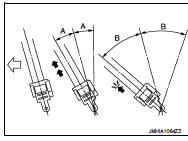
b. Center seat belt retractor
• The webbing can be pulled out when the angle (A) is 12 degrees or less.
• The webbing cannot be pulled out when the angle (B) is 13 degrees or more.
A and B : Tilting angles
 : Vehicle front
: Vehicle front
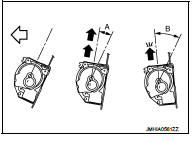
3. Replace the seat belt assembly if it does not operate normally.
Seat belt buckle : Removal and Installation
REMOVAL
1. Remove rear seat cushion from the vehicle. Refer to SE-33, "SEAT CUSHION : Removal and Installation".
2. Remove seat belt buckle mounting anchor bolt, and then remove seat belt buckle.
INSTALLATION
Install in the reverse order of removal.
Seat belt buckle : Inspection
AFTER A COLLISION
WARNING:
Inspect all seat belt assemblies including retractors and attached hardware
after any collision.
NISSAN/INFINITI recommends that all seat belt assemblies in use during a collision be replaced unless the collision was minor and the belts show no damage and continue to operate properly. Failure to do so could result in serious personal injury in an accident. Seat belt assemblies not in use during a collision should also be replaced if either damage or improper operation was noted. Seat belt pre-tensioners should be replaced even if the seat belts were not in use during a frontal collision in which the air bags were deployed.
Replace any seat belt assembly (including anchor bolts) if: • The seat belt is in use at the time of a collision (except for minor collisions and the belts, retractors and buckles show no damage and continue to operate properly).
• The seat belt is damaged in an accident. (i.e. torn webbing, bent retractor or
guide, etc.)
• The seat belt attaching point is damaged in an accident. Inspect the seat belt
attaching area for damage or
distortion and repair if necessary before installing a new seat belt assembly.
• Anchor bolts are deformed or worn out.
• The seat belt pre-tensioner must be replaced even if the seat belts were not in use during the collision in which the air bags are deployed.
PRELIMINARY CHECKS
1. Check that the seat belt retractor, seat belt anchor and buckle bolts are tightened firmly.
2. Repeat step above if necessary to check the other seat belts.
Seat belt hook : Removal and Installati
REMOVAL
1. Remove rear seatback from the vehicle. Refer to SE-33, "SEATBACK : Removal and Installation".
2. Remove rear seat cushion from the vehicle. Refer to SE-33, "SEAT CUSHION : Removal and Installation".
3. Remove luggage side lower finisher. Refer to INT-31, "LUGGAGE SIDE LOWER FINISHER : Removal and Installation".
4. From back of luggage side lower finisher, press pawls indicated by arrows as shown in the figure and remove seat belt hook from luggage side lower finisher.
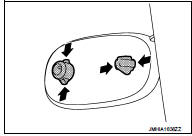
INSTALLATION
Install in the reverse order of removal.
 Front seat belt
Front seat belt
Exploded View
1. Adjuster cover
2. Anchor bolt
3. Shoulder anchor
4. Spacer
5. Retaining washer
6. Seat belt adjuster
7. Seat belt pre-tensioner retractor
(Passenger side)
8. Outer anch ...
 SRS Airbag
SRS Airbag
...
Other materials:
Performance test
Inspection
INSPECTION PROCEDURE
1. Connect recovery/recycling/recharging equipment (for HFC-134a) or manifold
gauge.
2. Start the engine, and set to the following condition.
Test condition
3. Maintain test condition until A/C system becomes stable. (Approximately 10
minutes)
4. Check t ...
U1010 control unit (can)
Description
CAN (Controller Area Network) is a serial communication line for real time
application. It is an on-vehicle multiplex
communication line with high data communication speed and excellent error
detection ability. Many electronic
control units are equipped onto a vehicle, and each co ...
The parking brake release warning continues sounding, or
does not sound
Description
• The parking brake warning buzzer sounds continuously during vehicle travel
though the parking brake is
released.
• The parking brake warning buzzer does not sound at all even though driving the
vehicle with the parking
brake applied.
Diagnosis Procedure
1.CHECK PARKING BRAKE ...
